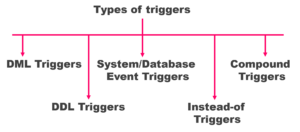With the previous tutorial, we finished the series of Iterative statements or looping statements in Oracle PL/SQL. So now it’s time to move on to a little more advanced topic in PL/SQL. Therefore today’s tutorial is about Introduction of Database Triggers in Oracle PL/SQL.
In this tutorial, I will try to explain to you the concepts of triggers and try to give you the answers of almost all the questions which you might face in your Certification Exam or in your Interview.
Definition of Database Triggers
Triggers are named PL/SQL blocks which are stored in the database. We can also say that they are specialized stored programs which execute implicitly when a triggering event occurs. This means we cannot call and execute them directly instead they only get triggered by events in the database.
[bctt tweet=”Triggers are named PL/SQL blocks which are stored in the database. Read more -” username=”Rebellionrider”]
Events Which Fires the Database Triggers
These events can be anything such as
- A DML Statement – An Update, Insert or Delete statement executing on any table of your database. You can program your trigger to execute either BEFORE or AFTER executing your DML statement. For example, you can create a trigger which will get fired Before the Update. Similarly, you can create a trigger which will get triggered after the execution of your INSERT DML statement.
- A DDL Statement – Next type of triggering statement can be a DDL Statement such as CREATE or ALTER. These triggers can also be executed either BEFORE or AFTER the execution of your DDL statement. These triggers are generally used by DBAs for auditing purposes. And they really come in handy when you want to keep an eye on the various changes on your schema. For instance, who created the object or which user. Just like some cool spy tricks.
- A system event. – Yes, you can create a trigger on a system event. And by a system event, I mean shut down or startup of your database.
- A User Events – Another type of triggering event can be User Events such as log off or log on onto your database. You can create a trigger which will either execute before or after the event. Furthermore, it will record the information such as time of event occur, the username who created it.
Types of Database Triggers
There are 5 types of triggers in the Oracle database. 3 of them are based on the triggering event which are discussed in the previous section.

-
Data Manipulation Language Triggers or DML triggers
As the name suggests these are the triggers which depend on DML statements such as Update, Insert or Delete. They get fired either before or after them. Using DML trigger you can control the behavior of your DML statements. You can audit, check, replace or save values before they are changed. Automatic Increment of your Numeric primary key is one of the most frequent tasks of these types of triggers.
-
Data Definition Language Triggers or DDL triggers.
Again as the name suggests these are the type of triggers which are created over DDL statements such as CREATE or ALTER. They get fired either before or after the execution of your DDL statements. Using this type of trigger you can monitor the behavior and force rules on your DDL statements.
-
System or Database Event triggers.
Third type of triggers is system or database triggers. These are the type of triggers which come into action when some system event occurs such as database log on or log off. You can use these triggers for auditing purposes. For example, keeping an eye on information of system access like say who connects with your database and when. Most of the time System or Database Event triggers work as Swiss Knife for DBAs and help them in increasing the security of the data.
-
Instead-of Trigger
This is a type of trigger which enables you to stop and redirect the performance of a DML statement. Often this type of trigger helps you in managing the way you write to non-updatable views. You can also see the application of business rules by INSTEAD OF triggers where they insert, update or delete rows directly in tables that are defining updatable views. Alternatively, sometimes the INSTEAD OF triggers are also seen inserting, updating or deleting rows in designated tables that are otherwise unrelated to the view.
-
Compound triggers
These are multi-tasking triggers that act as both statement as well as row-level triggers when the data is inserted, updated or deleted from a table. You can capture information at four timing points using this trigger:
- before the firing statement;
- prior to the change of each row from the firing statement;
- post each row changes from the firing statement;
- after the firing statement.
All these types of triggers can be used to audit, check, save and replace the values. Even before they are changed right when there is a need to take action at the statement as well as at row event levels.
The Syntax Of Database Trigger
CREATE [OR REPLACE] TRIGGER Ttrigger_name
{BEFORE|AFTER} Triggering_event ON table_name
[FOR EACH ROW]
[FOLLOWS another_trigger_name]
[ENABLE/DISABLE]
[WHEN condition]
DECLARE
declaration statements
BEGIN
executable statements
EXCEPTION
exception-handling statements
END;
For the detailed explanation of the syntax, I would suggest you watch the video tutorial. There I have explained each and every clause of the syntax in detail.
Uses of Database triggers.
- Using database triggers we can enforce business rules that can’t be defined by using integrity constants.
- Using triggers we can gain strong control over the security.
- We can also collect statistical information on the table access.
- We can automatically generate values for derived columns such as auto increment numeric primary key.
- Using database triggers we can prevent the invalid transactions.
[bctt tweet=”We can use #Database Triggers to Prevent Invalid Transactions. Read more” username=”Rebellionrider”]
Restriction on The Database Triggers
- The maximum size of the database trigger body must not exceed 32,760 bytes. This is because triggers’ bodies are stored in LONG datatypes columns.
- A trigger may not issue transaction control statements or TCL statements such as COMMIT, ROLLBACK or SAVEPOINT. All operations performed when the trigger fires, become part of a transaction. Therefore whenever this transaction is rolled back or committed it leads to the respective rolling back or committing of the operations performed.
- Any function or procedure called by a database trigger may not issue a transactional control statement. That is unless it contains an autonomous transaction.
- Declaring LONG or LONG RAW variable is not permissible in the body of the trigger.
This blog is written keeping in mind the perspective of Certification Exam and Interview. Hope you enjoyed reading. Don’t forget to share this blog on your social media and help others in learning.
In case if you have any doubts feel free to leave me a message on my Facebook or Twitter.
Thanks & have a great day.








